As a young man, Captain Ashmore sought to follow in his family’s footsteps and serve his country. He joined the US Navy in 1949 after graduating from Paris High School and Paris Junior College and was determined to pursue a military career that included his longtime passion for aviation. In 1950, Captain Ashmore completed aviation school and later participated in numerous combat flights over Korea. While stationed in the Sea of Japan during the Vietnam War, he took part in the 1968 Tet Offensive and flew 254 combat missions. For his outstanding service, Capt. Ashmore received numerous awards, including the Silver Star, two Distinguished Flying Crosses, two Bronze Stars, the Legion of Merit, and many more. His final duties as a Naval officer was with the Joint Chiefs of Staff where he briefed senior elected officials on national security matters. After retiring in 1973, Captain Ashmore continued to fly planes as a community volunteer and even taught friends and family how to fly. In recognition of Capt. Ashmore’s distinguished career and selfless service, he received the Distinguished Student Award from Paris High School and a position on Paris Junior College’s Wall of Honor.
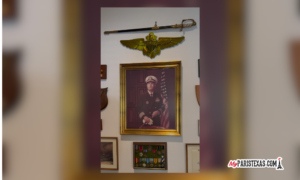
Q: How did you join the military?
A: “I was giving a talk one time to some kids in high school about career planning, and I said I didn’t plan mine. It just kind of happened when I graduated from Paris Junior College, which was, incidentally, the foundation of my whole academic career. Those two years out there was fantastic, It qualified me for the Navy flight training program, and then I was later commissioned and my military career took off from there. Somebody said ‘you planned it’. I said, ‘well, no‘.
I’ve been fiddling around airplanes ever since I could remember. When I was in school, we were having an assembly out at the college and the president of college here introduced this young man, young naval aviator, senior Lieutenant. He was in his dress blues, beautiful big gold wings. I think this guy was probably recruited right out of Hollywood because when he walked across the stage, I think every girl in there swooned. And I was looking at the naval aviator, I said, ‘you know, I think I’d like to be one of those‘.
So like I say, there was my planning. After that, I qualified and was entered into the flight training program in Pensacola.”
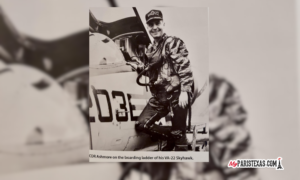
Q: After you joined up, what happened from there?
A: “Well, you go to Pensacola, FL, for 16 weeks of intensive ground school, physicals, all kinds of learning to drill, baby things and what have you. If you get through that, then you start into the flight training program and you have about a year or so of intensive what we call basic training. In those days we had a airplane which is the Air Force version of the T6. Once you qualify that, they send you to Corpus Christi, TX. And then you fly what we call ‘service type’ or the airplane you’re going to fly in a fleet.
And my situation ended up by flying the AD Skyraider, which was the attack airplane in service after World War 2. It kind of took the SD’s place and that’s what I was.
I went to Korea as a bright eyed young ensign. You really learn right away that you’re not bulletproof. When you fly your first combat mission, people start shooting at you. So anyway, that’s kind of the way I got there.”
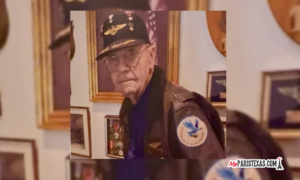 Q: How many combat missions did you fly in total?
Q: How many combat missions did you fly in total?
A: “In total, let’s say I had probably close to 100 missions in the Korea era and 241 and the Vietnam era. I made three tours to Vietnam. And sometimes, that’s almost one too many. We were just trying to meet ourselves, coming and going in Vietnam, we didn’t have enough carriers to keep the operations going like we wanted, so we were having to double up. A whole bunch of my tours, which is supposed to have been six months, ended up being nine months.
I got stuck with another tour, but yeah, that was about it in the Vietnam War, since I was what we call an attack pilot flying AD’s, then we got jets in the Navy. And actually I transitioned into the A4 Skyhawk, which is probably the last really great combat airplane. I flew that airplane for three tours in Vietnam. I did get to fly the F4 and our new airplane the A7. I didn’t get to fly it very much, but we had some. And that was about it.
I had a real dear friend of mine. He took over command of an F4 squadron at about the same time that I took over my A4 squadron. We were very, very good friends. Alex said his pilots needed to learn how to dive bomb. They were strictly interceptor pilots. I went and flew down to Miramar where the Phantoms were stationed and checked out the F4. Alex and I were up flying this thing and I was doing like you do, checking out the airplane. I had turned aside to do stalls and I pulled it up into a stall. It did a stall I was going to push the nose over, which is standard recovery from a stall.
And he said, ‘oh, don’t do that. Just hit the burners‘ and it just flew right out of the stall. And I said ‘now this is nice!’ I liked that.”
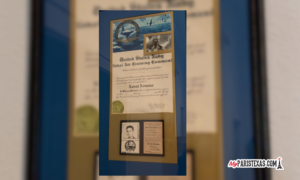 Q: What was it like for you in first in the Korean War, and then in the Vietnam War?
Q: What was it like for you in first in the Korean War, and then in the Vietnam War?
A: “When I went to Korea I was a bright eyed ensign. I thought I was bulletproof and all this, like everybody else.
First time I got hit real hard, this was a real funny one. I was flying out on the skippers wing and we went into this target area. I felt this Big Bang and man I thought I was hit big time. The airplane took a big roll, uncontrollable almost, but I don’t even remember how – but, I got the tabs that stick over to deploy.
I stop the roll and start it up and my skipper said when I first called up I sounded like a Soprano.
‘I’m hit!
I’m hit!’
The skipper comes charging over to see what’s happening. In the meantime, the airplane, I had it kind of semi under control. The stick was shaking. I couldn’t figure out why, but anyhow I’m climbing. Got a little out to about 3,000 or 4,000 feet up. My voice came back, and I think I’m going to be able to fly. The skipper said, ‘well, you got to get to 5,000 or 6000 feet, and we’re headed back to the ship‘. I got this one under control and I was able to get it back safely. But, as I say, you learn lots of things when you’re young and dumb.
The other one was we were out there and you know, when I signed up, the old aviation program, it was for four years. Well, I had spent two years just about getting my wings and I was on my second tour out to Korea. You know, I was a big Lieutenant JG there and I thought I really was somebody. I looked at my ID card and the ID card has what they call an RAD (release from active duty) date on it and mine had long since expired.
And so, being the bright eyed kid I was, I went charging down to my CO and I went and I said ‘Sir. Look at this, I’m supposed to be home‘.
He said, ‘Mr. Ashmore, did you read your Commission real well‘?
And I said that I thought I had..
He said, ‘you serve at the convenience of the President of the United States. And I can assure you it is not convenient for you to get out right now‘. So, he took my ID card out of my hand, handed it to the Yeoman, and said ‘make Mr. Ashmore a new ID card.’ He cut my old one, went into the office and typed up a new one. It said: RAD: Indefinite.
Of course, it was a reserve commission, so they could drop you whenever they wanted to.
But, anyhow, that was as I say, “planning” my career. Not hardly. It just happened.
After that tour, I was going to get out, but they gave me a cushy set of orders to a little town in South Texas called Beeville. They were going to start jet training in the Navy. We were just getting jets and I was part of the nucleus of the large DB agent instructors. So, I went down there. I thought I’d stick around as a reserve until I find a job or something. I needed to go back and finish my college. So, while I was there I instructed flying jets and it was as much fun as I’ve ever had in my life with my clothes on.
I flew up one weekend to Dallas and I talked to American Airlines and I said, ‘hey, would you guys like to have a pilot with some jet experience‘ for all the airlines that were just getting jets, too. And if you hadn’t even ever looked at a jet that they just bought, they’d still hire you.
So this guy said, ‘oh, we’ll take you‘.
When I got back on base I got a call that the CO wants to see me right away. So, I went charging up to the big boss’s office.
‘I hear you’ve been talking to the airlines.’
I thought, my God, I thought wives were bad. I told him that American Airlines said they’d hire me.
He said, ‘well you don’t want to do that – I tell you what, if you will sign here we will give you a regular Commission and we will send you to school and we’ll pay for your education‘.
So, that’s when I really made a career decision. They made it for me. I signed up. That’s the way I ended up being a regular commissioned officer. And like I say, 26 years later, I retired. And I will say this, the Navy did everything that they said. They said we’ll promote you to senior Lieutenant. Which they did. They sent me out to Monterey, finished my undergraduate work, got a degree. I stuck around and they kept sending me to school. Every time I got promoted and needed a little more education, they sent me to school. I had ended up getting a masters degree from George Washington University while I was at War College. So, in that aspect, they were really good to me. As I say, the Navy was really good.”
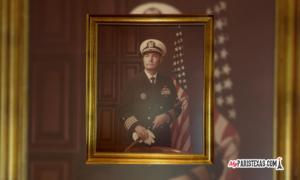 Q: Do you ever think about the path not taken? Do you ever wonder what your life would have been like if you took the airline job?
Q: Do you ever think about the path not taken? Do you ever wonder what your life would have been like if you took the airline job?
A: “I’ve thought about it, but I’ve had some friends that went that route. You’re a glorified bus driver. It’s boring.
You know, there was a lot of things that weren’t good. I would have had to go to school, pay for it myself and I was trying to figure out when would I work in the time to go to school. But, the Navy did all this for me. It ended up being a good decision. But, you’re right, at times I thought and wondered if I’d have gone this way, what would have happened?
But I look at it this way, the Good Lord was looking out after me has been all my life, seeing me through all these combat tours. So, I figured He knew what was best.
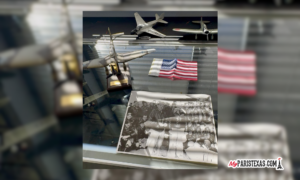 Q: There was another point or two on education in particular that you wanted to hit on?
Q: There was another point or two on education in particular that you wanted to hit on?
A: “Yeah, you know, in World War II, in times like that, my brother was in the Army Air Corps and he went in right out of high school and got his wings and all. He flew all over the Pacific in World War II. Like I say, I had to have two years of college even to get in. Well, now we’re years later here and here I’ve got a squadron of young pilots. I had a Lieutenant Commander in my squadron who was my operations officer. He was fresh out of MIT with a PhD in nautical engineering. I hated to put him on a flight. Society cannot afford to lose people like that. Most everybody in my squadron were engineers, all the young lieutenants and the JG were all engineering graduates. That’s how I felt, uneducated, because at that time all I had was a bachelor’s degree.
Incidentally, that Lieutenant Commander went on to make Admiral and I had another young Lieutenant under my command, he was a Naval Academy graduate. He had a master’s degree and he made four-star Admiral. His last duty station was the same job that Eisenhower had.”
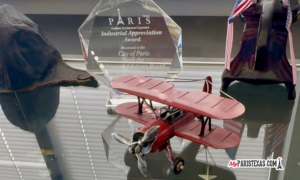 Q: Could you tell the audience a little bit about how you closed out your military career with your service over at the Pentagon?
Q: Could you tell the audience a little bit about how you closed out your military career with your service over at the Pentagon?
A: “The Navy, they were still educating me and they sent me to get my master’s degree with George Washington University and War College and I got promoted to Captain. Fortunately, I got a good job with the Joint Chiefs of Staff.
I was a head of the analysis branch in a junior cabinet, which was really good. Probably one of the most gratifying jobs I had. I got to meet with people like Henry Kissinger, Melvin Laird. Admiral Tom Moore (who was then the chairman of the Joint Chiefs) and I had met back during our war days. People like that, they had some of the most brilliant minds that I’ve ever seen. Melvin Laird was probably the smartest man in Washington, DC, I really believe he was. He had a mind like a steel trap.
You know, everybody hates the Pentagon for various reasons. You hate living in that area because it’s so congested and of course you have to go to work about 6:00 in the morning to beat all the traffic and you don’t get home till the wee hours of night.
As my youngest son said, ‘Daddy was a lot more fun on combat deployments‘.
I got to see him a lot more, but I lived in the Pentagon just about. That was a great tour, but, I hit that magic number of years served. You don’t get any pay raises after that. And I didn’t make the carrier command list. And if you don’t make that as a Captain, you might as well get out.
My youngest son was coming up on 13 years old. I’d never had a chance to take him hunting or fishing. My youngest one was about 7 and I thought I was offered a tremendous opportunity down in Beeville. I love the little old town. So, anyhow, that was my retirement. Never have regretted that.
It has been a lovely life since then.
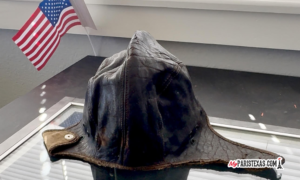 Q: Once you got out, what did you do next?
Q: Once you got out, what did you do next?
A: “OK, I got out, went back to Beeville and opened up our management agency. I had a friend that I’d gone to college with. He was a big builder in the state of Texas, and he was building apartment complexes for HUD. He said ‘I’m going to build these things but I need a management agency to manage them all for me.’ So, that was my job. Paid good money, too. But anyhow, I’d been there about a year doing that as my management HL was set up. I had apartments in Beeville, Quiero, Del Rio and Eagle Pass and I ran this for him.
Well, after a year, I had made friends with the president at the local college and he called me.
He asked if I had a master’s degree? He said, ‘man, I need some help. I have an instructor, she’s gotta go in for an operation, going be out for about 6 weeks. Can you fill in for me?’
I said OK, so I went out there teaching economics and management.
It was supposed to be for six weeks.
17 years later, I retired from it. I recall that I really enjoyed teaching and enjoyed the classroom.”
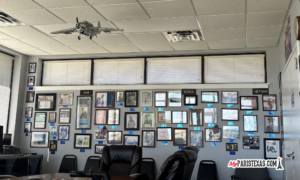 Q: Any final thoughts for the audience? Anything you want to share out?
Q: Any final thoughts for the audience? Anything you want to share out?
A: “Well, I used to hang out at the local airport all the time.
When I was actively flying, I had a little Bonanza aircraft, flying around out there and we’re sitting there, a bunch of guys that drink coffee in this little conference room. I got a phone call from a friend downtown who is a realtor and he tells me he was cleaning out this building and found this box.
Pictures are in there and he found a picture of this guy. Said he looks like a Navy pilot standing in front of this great big airplane.
Now, people know I’m a naval aviator. Lord, you know, I’m supposed to know every naval aviator in the world like this.
I told him, ‘I don’t know. Bring it out here. We’ll look at it.’
He brought it out there and we’re all sitting there looking at it. Sure enough, I recognize it was an old World War II SBD dive bomber. And sure enough, the guy standing there had a jacket on, had gold wings, and he had gold leaves on his collar, which made him a major or Lieutenant Commander at that time. I look and he was wearing a khaki tie. Well, a khaki tie is worn by Marines. They’re all wearing naval aviator wings in the photo.
In the mans hand, there was about 1/2 of a cigar sticking out. I looked at that and I said I sit next to him every Sunday. His name was Colonel Barr. He was a dear friend of mine and somebody said, you know, we ought to put him on the wall.
Long story short. This kind of got out. The paper started talking about it. Next thing you knew, I now have a museum out at Cox Field. I think I have got 80 or 90 some odd pictures on the wall or better. We call it a museum, if you will. I’ve got everything in there. And these are all pictures on the wall of local area people who were pilots, Navy, Air Force, Army, what have you. I even have the Chief of Staff of the US Air Force on our wall. He was a Paris boy. And I have a picture of a World War I United States Army signal corps pilot, a Paris boy.
So, if you want to really see something that’s interesting, come out there, it’s history in the making. I start with World War I, come all the way around the present with pictures, and it’s kind of interesting and fun to see. It’s real history. If you’re interested in military history in Paris, that’s the place to go. I’ve enjoyed doing it. It’s still a pretty nice place.
I have one of just about every kind of airplane model hanging from the ceiling. I’ve got 3 display cases full of models. I’ve put them in there. People realize that some of those models cost lots of money and we did not have any funding for this museum. It all came out of my pocket except for some donations from Doctor Strom and Glenn Chapman, two friends of mine. They helped me buy the display cases, but everything else out there I’ve got a footed the bill for, but I’m kind of proud of it and we get a lot of visitors that come through and they’re always impressed with it.
It has been fun.
I’ve enjoyed that place.”
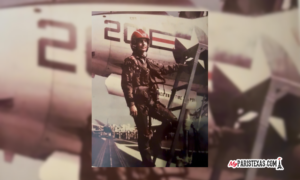 Editor’s note: If you are in Lamar County or Northeast Texas, you should make it a point to make a trip to Cox Field and take a look at the faces of history and some of the machines that they have piloted and worked on. Stop by up there at the museum. Maybe Captain Jack will be there and will have a cup of coffee with you. Ask him to tell you a story.
Editor’s note: If you are in Lamar County or Northeast Texas, you should make it a point to make a trip to Cox Field and take a look at the faces of history and some of the machines that they have piloted and worked on. Stop by up there at the museum. Maybe Captain Jack will be there and will have a cup of coffee with you. Ask him to tell you a story.
It is important that America remembers the veterans, the people who have protected this country for 249 years.
A lot of America is because of the veteran.
We owe them our thanks and gratitude.

